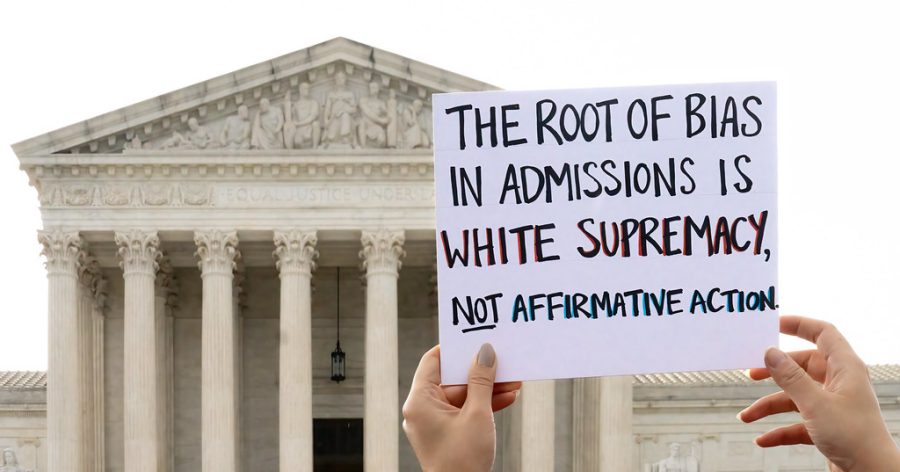The Death of Affirmative Action
A protest sign front of the Supreme Court on Oct. 31, 2022. Image by Victoria Pickering on Flickr.
November 21, 2022
On Oct. 31, the Supreme Court heard arguments for cases aimed at eliminating the consideration of race from college admissions. The two cases, brought on by Students for Fair Admissions (a conservative group aiming to end affirmative action), are against the University of North Carolina and Harvard – claiming that the schools discriminate against white and Asian applicants and favored Black and Brown students. Ultimately, SFFA’s goal is to eliminate all race considerations from the application process.
Affirmative action is one of the most unpopular issues among Republicans and Democrats alike. Over 6 in 10 Americans are against the use of race in college admissions yet an almost equal number are in favor of programs aimed at increasing racial diversity.
There is a fundamental misunderstanding of what affirmative action is, its purpose, and its effects. Many people would describe affirmative action as a form of “reverse racism” – a way to give a leg up to Black and Brown people while simultaneously discriminating against white and Asian Americans. This is far from the truth and is in reality, a product of misinformation.
Affirmative action is defined as “the use of policies, legislation, programs, and procedures to improve the educational or employment opportunities of members of certain demographic groups.”
Affirmative action first appeared in executive order 10925 in 1961 by President John F. Kennedy. With the goal of creating a more diverse workplace and as a remedy for past discrimination, the order required employers that were contracted with the government or received federal funding to document their practice and methods for increasing diversity.
Affirmative action has a long history of legal battles and precedents. The Supreme Court case, Regents of the University of California v. Bakke (1978), established that the use of racial quotas was unconstitutional, but affirmative action and race consideration were permitted. That is as long as it wasn’t used to remedy past discrimination. The case additionally outlined that affirmative action can only be used to increase diversity for the benefits it provides in education.
Two cases brought on by white applicants rejected from the University of Michigan, Gratz v. Bollinger and Grutter v. Bollinger (2003), solidified the constitutionality of affirmative action but imposed further limits; schools could not use a point system in race considerations. Rather, they were required to view race on an individual basis – as one of the several aspects of an applicant’s profile. Grutter further established that affirmative action should no longer be needed in 25 years.
Affirmative action has been threatened numerous times throughout its history and in its current state, is relatively limited in its use. Race is not a major factor in an applicant’s admissions but instead, provides a more complete picture of an individual’s identity and experiences.
Students for Fair Admissions has a long history of challenging race-conscious policies. The organization’s website states that they believe “that racial classifications and preferences in college admissions are unfair, unnecessary, and unconstitutional.”
Despite their claims of restoring fairness in admissions and the “original principles of our nation’s civil rights movement,” SFFA’s president Edward Blum is an angry white man whose mission it is to protect white privilege in our institutions.
Blum has helped organize over two dozen lawsuits against affirmative action. Though not a lawyer, Blum has received millions in donations from conservative donors to fund his legal endeavors.
Following a failed run for congress in Houston in 1992, Blum claimed that the voting districts were shaped to make minority victories easier, so he sued the state of Texas. In 1996, the Supreme Court voted in his favor in the case Bush v. Vera.
Blum didn’t stop there. In 2013, he further challenged voting rights by going after a key piece of legislation of the Civil Rights Movement – the Voting Rights Act (1965). In the Supreme Court case, Shelby County v. Holder (2013), the court ruled that two of the provisions were unconstitutional. Sections 4(b) and 5 essentially said that states, counties, and municipalities (including Alabama, Mississippi, South Carolina and Texas, among others) that were found to have had voter discrimination were required to have their voting laws checked by the federal government. The ruling on these sections allowed for redistricting, new voting laws to be passed unchecked, and ultimately, for voter suppression to worsen.
Five years following the ruling, almost a thousand polling locations were closed throughout the country, disproportionately affecting Black communities.
Make no mistake, Edward Blum is not fighting for people of color. He has shown throughout his career that his only priority is the maintaining of systemic white privilege.
Blum orchestrated one of the most recent attempts of ending affirmative action that went to the Supreme Court in 2016. Fisher v. the University of Texas was based on a white woman, Abigail Fisher, who was rejected from UT Austin and claimed unlawful discrimination due to UT’s race consideration as a part of their holistic review. The court upheld the university’s use of race consideration in admissions and stated that it was constitutional as long as schools could prove that race-neutral alternatives did not achieve desired diversity.
Now, Blum is weaponizing Asian Americans in his continued battle against race-conscious admissions. History has shown that Blum is focused on furthering his white agenda and with a different approach, using Asian Americans as political pawns, Blum and his white agenda are poised to win.
We have already seen what an affirmative action ban means for applicants, and it’s no surprise; Black and Brown students are negatively impacted.
California outlawed affirmative action in 1998 when its residents voted for Proposition 209 (it is one of the 9 states to have done so), and the effects are clear. Before the ban, Black students made up 7 percent of the UCLA student body and by 1998, they made up only 3.93 percent. By the fall of 2006, the freshman class included only 96 Black students out of almost 5,000 enrolled students total.
A study out of UC Berkley on Proposition 209 found that Black and Hispanic students were negatively impacted in admissions, graduation rates, and even future salaries. White and Asian students were also not benefited as much as many expected.
Affirmative action is flawed. But its main issue is certainly not the claimed reverse racism faced by white people. In fact, affirmative action does more to benefit rich, white, America, than many of us would imagine.
A whopping 43% of Harvard’s white students did not get it based on merit. These students, referred to as ALDCs, represent the privileged and elite in our institutions. These are recruited athletes, legacies, on the dean’s interests list (aka their parents donated large sums of money), or children of faculty or staff.
If the race aspect of affirmative action gets ruled unconstitutional (likely in summer 2023) we can expect decreases in Black and Brown admissions across our top institutions.
Essentially, one student will be able to honor their family legacy and background by being admitted as a legacy (a disproportionately white group), but another cannot honor their family legacy as a first-generation immigrant as that aspect of their character is directly tied to their race.
Supporters of ending affirmative action have said that applicants should speak on their cultural experiences in their essays. What they fail to realize is that many of these cultural experiences are tied to race. Saying applicants cannot speak on or have their race considered, invalidates their experiences.
Affirmative action is not what is preventing us from reaching a world of equal opportunity in our education. Deep-rooted, historical, and systematic advantages for white people – particularly rich white people – are.
Asian Americans have undoubtedly faced discrimination and continue to do so. However, getting rid of affirmative action will not end the implicit bias permeating our society and college admissions.
As nice and cheery as a colorblind admissions process seems, it is simply unrealistic and in reality, a deeply harmful philosophy. The truth of the matter is, we do not live in a colorblind society, and pretending that in our current world a colorblind reality is possible, comes from a place of ignorance or purposeful oppression.
Affirmative action is imperfect, as is our entire college admissions process. Taking the racism out of an inherently racist system is difficult, and requires serious reflection on our inequitable processes.
Ultimately, we should strive for a society in which affirmative action is not needed, where POC are truly on a level playing field in their access to higher education. We must ensure equal opportunity for K-12 students of all races and backgrounds, but that is not our current reality, and we are far from it.


